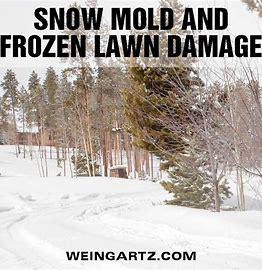
Introduction Winter can be tough on your lawn, especially after heavy snowfall. Snow, ice, salt, and foot traffic can leave your grass and landscaping in rough shape. Knowing what to look for after the snow melts can help you address damage early and restore your lawn's health. Here are key signs of post-snow damage and what you can do about them.
1. Snow Mold One of the most common lawn issues after winter is snow mold. This fungal disease appears as gray or pinkish patches on your grass. It thrives under heavy snow cover where moisture and low temperatures create the perfect environment for mold growth. To help your lawn recover, gently rake the affected areas to improve airflow and promote drying. Aeration in the fall and proper mowing before winter can help prevent snow mold in the future.
2. Salt Damage Salt from roads, driveways, and sidewalks can be harmful to grass and plants. Look for areas near walkways and streets where grass appears brown or dead. Salt can dry out the soil and damage root systems. To mitigate the effects, flush affected areas with water in early spring to help wash away excess salt. Consider using calcium chloride instead of rock salt, as it’s less harmful to plants.
3. Compacted Soil and Foot Traffic Damage When people or pets walk on snow-covered lawns, they compress the snow, which can lead to compacted soil and weakened grass roots. In spring, you may notice thin or bare patches in high-traffic areas. Core aeration can help loosen the soil and improve airflow to encourage new growth. Consider placing temporary pathways or using mulch in high-traffic zones to protect your lawn in future winters.
4. Ice Damage Thick layers of ice can suffocate grass and prevent proper drainage. If you notice large dead patches or excess water pooling, it could be due to ice damage. Aerating the lawn and ensuring proper drainage can help prevent this issue. Avoid using heavy equipment to break up ice, as this can cause further damage to your grass.
5. Rodent and Wildlife Damage Voles, mice, and other small animals often burrow under snow, creating trails and eating away at grass roots. If you see tunnel-like pathways or dead grass strips, these could be signs of rodent activity. Raking up debris and keeping your lawn properly trimmed before winter can help reduce nesting areas. In spring, overseeding and fertilizing can help repair the damage.
Conclusion Snow and ice may create a beautiful winter wonderland, but they can also leave behind a mess for your lawn. By identifying and addressing damage early, you can help your lawn bounce back stronger in the spring. Regular maintenance, proper fall lawn care, and preventative measures can make all the difference in protecting your grass from winter’s harsh effects. If you need professional help reviving your lawn, our team is here to assist!